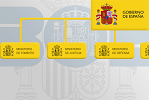Transporting animals when travelling within the EU
Content
Travelling with your pet. Dogs, cats and ferrets
It is considered to be a pet move when:
- Five animals or fewer are moved. Exceptions are made for properly documented competitions, shows or sporting events for animals over 6 months old.
- There is no commercial purpose or transfer of ownership.
- The animals are accompanied by their owner or a person who takes charge of the animal or animals on their behalf while travelling. The animals may be moved by a means of transport separate from that of the owner if this occurs within no more than five days of the journey of the owner/person in charge.
Travelling to Spain from an EU country
Any pet dog, cat or ferret brought into Spain must:
- Be identified with a microchip, or tattoo (if this was done before 3 July 2011) as long as it is still readable.
- Be vaccinated against rabies with a vaccine that is valid at the time of travel and recorded in the passport.
- Have a European passport for travelling with pets. The sections ‘Details of ownership’, ‘Description of animal’, ‘Marking of animal’, ‘Issuing of the passport’ and ‘Vaccination against rabies’ must be completed in the passport (see annex I of the Instruction
 ). When travelling from other Member States to Spain, it is not compulsory to complete the sections on Rabies serological test, Tick treatment, Anti-echinococcus treatment, Other vaccinations, Clinical examination, Legalisation and Others.
). When travelling from other Member States to Spain, it is not compulsory to complete the sections on Rabies serological test, Tick treatment, Anti-echinococcus treatment, Other vaccinations, Clinical examination, Legalisation and Others.
No exceptions are granted and dogs, cats and ferrets under 15 weeks old, and therefore not vaccinated with a valid rabies vaccination, are not allowed to enter Spain:
- The minimum age for vaccinating animals is 12 weeks.
- At least 21 days must elapse after inoculation for the vaccine to be valid.
Travelling from Spain to an EU country
To travel to the EU from Spain, your pet must:
- Be identified with a microchip, or tattoo (if this was done before 3 July 2011) as long as this is still readable.
- Be vaccinated against rabies with a vaccine that is valid at the time of travel.
- Have a European passport for travelling with pets.
If you are travelling to the Ireland, Northern Ireland, Malta, Finland or Norway, you must also:
- Treat your dog against E. multilocularis between 24 and 120 hours before arriving in the country.
Travelling with your pet. Birds.
It is considered to be a pet move when:
- There are no more than five animals, if they are coming from a third country.
- There is no commercial purpose or transfer of ownership.
- The animals are accompanied by their owner or a person who takes charge of the animal or animals on their behalf while travelling. The animals may be moved by a means of transport separate from that of the owner if this occurs within no more than five days of the journey of the owner/person in charge.
If you do not meet these requirements when moving your animal or animals, it will be considered a commercial operation.
Travelling to Spain from an EU country
To introduce pet birds into Spain from another EU country, they must be accompanied by an animal health certificate issued by a vet and compliant with the INTRA-2 template![]() , drafted at least in Spanish, and issued within the last 10 days.
, drafted at least in Spanish, and issued within the last 10 days.
Poultry (as defined in Regulation (EU) 2016/429![]() ) are never treated as pets.
) are never treated as pets.
Travelling from Spain to an EU country
The rules for moving birds between Member States are not harmonised at EU level, so each country can set its own rules (additional requirements or health certificate to bring them in).
Follow this link to a page on the European Commission website![]() that sets out the requirements of different Member States.
that sets out the requirements of different Member States.
If this is not available or you cannot find the appropriate information, please email us at traces@mapa.es (only for enquiries about travelling within the EU) to ensure this information request can be handled through the health authorities.
If you wish to travel with your pet, try to allow enough time to ensure that you meet the health requirements of the destination countries when planning your trip.
If you are going to return to Spain at a later date, read the information in the section: Travelling to Spain from a European Union country.
Travelling with your pet. Other species
Other animal species can be regarded as pets under Regulation (EU) No 576/2013 of the European Parliament and of the Council: invertebrates (with some exceptions), ornamental aquatic animals, amphibians, reptiles, rodents and rabbits (other than animals for food production within the meaning of Regulation No 853/2004).
It is considered to be a pet move when:
- There is no commercial purpose or transfer of ownership.
-
The animals are accompanied by their owner or a person who takes charge of the animal or animals on their behalf while travelling. The animals may be moved by a means of transport separate from that of the owner if this occurs within no more than five days of the journey of the owner/person in charge.
If you do not meet these requirements when moving your animal or animals, it will be considered a commercial operation.
Travelling to Spain from an EU country
To bring pets into Spain from another EU country (with the exception of ornamental fish) they must be accompanied by an animal health certificate issued by a vet and compliant with the relevant INTRA template, drafted at least in Spanish, and issued within the last 10 days:
- INTRA certificate for bringing reptiles into Spain as pets.

- INTRA certificate for bringing other pets into Spain.

Travelling from Spain to an EU country
The rules for moving other animal species between Member States are not harmonised at EU level, so each country can set its own rules (additional requirements or health certificate to bring them in).
Follow this link to a page on the European Commission website![]() that sets out the requirements of different Member States.
that sets out the requirements of different Member States.
If this is not available or you cannot find the appropriate information, please email us at traces@mapa.es (only for enquiries about travelling within the EU) to ensure this information request can be handled through the health authorities.
If you wish to travel with your pet, try to allow enough time to ensure that you meet the health requirements of the destination countries when planning your trip.
If you are going to return to Spain at a later date, read the information in the section on Travelling to Spain from an EU country.
Información por Comunidades Autónomas



Andalucía Aragón Asturias, Principado de Balears, Illes Canarias Cantabria Castilla y León Castilla-La Mancha Cataluña Ciudad de Ceuta Ciudad de Melilla Comunitat Valenciana Extremadura Galicia Madrid, Comunidad de Murcia, Región de Navarra, Comunidad Foral de País Vasco Rioja, La
Legal and/or technical references
-
Regulation (EU) No 576/2013 of the European Parliament and of the Council on the non-commercial movement of pet animals.

-
Commission Implementing Regulation (EU) No 577/2013 on the model identification documents for the non-commercial movement of dogs, cats and ferrets.

-
Commission Delegated Regulation (EU) 2018/772 supplementing Regulation (EU) No 576/2013 of the European Parliament and of the Council with regard to preventive health measures for the control of Echinococcus multilocularis infection in dogs, and repealing Delegated Regulation (EU) No 1152/2011.

-
Commission Decision 2007/25/EC of 22 December 2006 as regards certain protection measures in relation to highly pathogenic avian influenza and movements of pet birds accompanying their owners into the Community.

-
INSTRUCTION 1/2014 of the Directorate-General for Agricultural Production Health concerning the introduction into Spain of dogs, cats and ferrets from other Member States for non-commercial purposes











